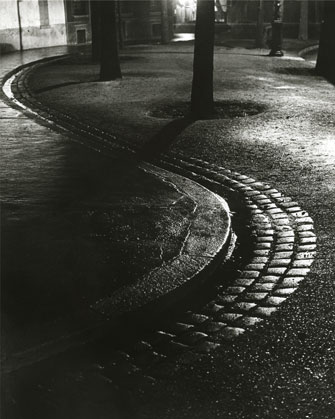The Man Who Captured
‘The Beauty of Sinister Things’

Brassaï’s “Le Ruisseau qui Serpente” (1932-33).
Brassaï is known as the master of night photography, and it is indeed those images that shine the brightest in the exhibition “Brassaï: For the Love of Paris” at the Hôtel de Ville. Who can forget his image of the hefty prostitute with the build of a refrigerator and a cigarette jutting from her lips standing defiantly, hand on hip, in the light of a streetlamp? Or the abstract patterns formed by slick, gleaming cobblestones?
Born Gyulus Halasz in Transylvania in 1899, Brassaï was not a photographer when he arrived in Paris in 1924, but he became one to record his impressions of Paris. As he wrote in the preface to Brassaï: The Secret Paris of the 30s (1974): “During my first years in Paris, beginning in 1924, I lived at night, going to bed at sunrise, getting up at sunset, wandering about the city from Montparnasse to Montmartre. And even though I had always ignored and even disliked photography before, I was inspired to become a photographer by my desire to translate all the things that enchanted me in the nocturnal Paris I was experiencing.”
Brassaï had always dreamed of returning to Paris after spending a year there as a small boy with his father, a professor of literature, a visit that left him with an enduring nostalgia for Belle Epoque Paris. During his nighttime wanderings through the City of Light, he was often in the good company of friends who guided him through their favorite neighborhoods, among them Henry Miller, Léon-Paul Fargue, Raymond Queneau and Jacques Prévert. The letter wanted to show him “the beauty of sinister things,” which he captured so brilliantly with his camera. Brassaï occasionally catches the “decisive moment” à la Henri Cartier-Bresson, as in the incredibly charming “Enfants” (c. 1930), in which a little girl and boy who are obviously enthralled with each other sit on a stoop with their heads tilted toward each other and huge grins on their faces, or “Couple au Zinc d’un Bistrot, Rue de Lappe” (1930-32), in which the man’s lust is evident in his eyes as he looks at his girlfriend. But the genius of most of his images lies in the framing, subject matter and use of light.
The show offers works from the 1920s to the beginning of the ’40s, and, in addition to the ”Paris by night” photos, includes many lesser-known images, including his photos of graffiti; high society at the races; parks; the circus, shop windows; celebrities like Picasso; and more. At the beginning of the exhibition, photos from Brassaï’s collection of images of Belle Epoque Paris are juxtaposed with his own images to show how they influenced his work.
The Belle Epoque was Proust’s era, and Brassaï once described his memories of that childhood visit as his “madeleines.” When he arrived in Paris, he taught himself French by reading Proust, and near the end of his life (he died in 1984), he wrote a book called Marcel Proust sous l’Emprise de la Photographie (rather awkwardly translated by the University of Chicago Press as Proust in the Power of Photography) about Proust’s use of photography as a way “to halt the moment, to wrest it from the flux of duration in order to ‘fix’ it forever in a semblance of eternity.”
Note: A free app of the exhibition is available for iPads and Androids, but seeing a reproduction is no substitute for seeing the original prints.
Hôtel de Ville: Salle St-Jean, 5 rue de Lobau. 75004 Paris. Métro: Hôtel de Ville. Tel.: 01 42 76 51 53. Open Monday-Saturday, 10am-7pm. Closed on public holidays. Through March 29, 2014. Free admission. www.paris.fr
© 2013 Paris Update
Favorite